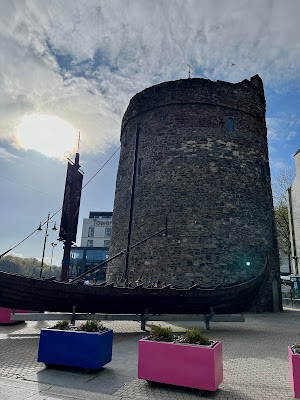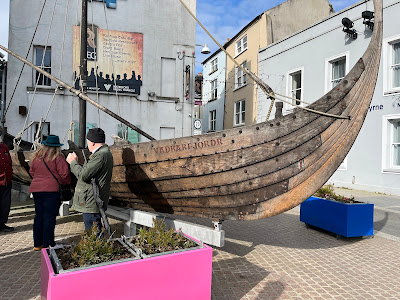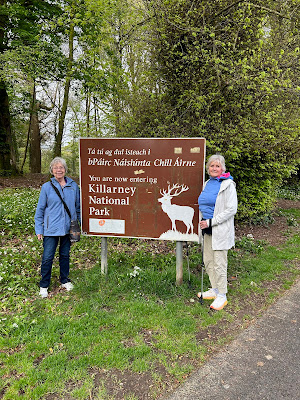There's something about Bundt cakes that make them seem more special than a sheet pan cake. Thier decorative shape and denser texture make the same ingredients into a party time treat. Bundt cakes are baked in a tubed circular pan invented in the mid 1950s by Nordic wear that continues to carry the name even when baked in other brand's pans. A Tunnel of Fudge cake entered in the 1966 Pillbury BakeOff contest caught home bakers attention and the inverted fluted shape has been popular since.
This fall Southern Living magazine featured some Bundt cakes in their food section. So when I needed cakes for church coffee time and other events, I tried two of them. The recipes are 'keepers' in my book. l like bundt cakes to serve because of the decorative look they have but also because they don't require frosting, just a glaze dribbled over the top is good. Bundt cakes are a little more dense and easy to serve because of the greater amount of batter exposed to the pan sides, making a darker browned crust.
Here are the two recipes I recommend:
APPLE CIDER-DOUGHNUT BUNDT CAKE
½ cup packed light brown sugar
1 ¼ cups granulated sugar, divided
1 cup unsalted butter, softened and divided
3 large eggs
2 tsp. vanilla extract
3 cups all-purpose flour (300 grams)
1 ½ tsp baking powder
1 tsp. kosher salt
½ tsp. baking soda
2 ½ tsp. ground cinnamon, divided
1 ¼ tsp. ground ginger, divided
¾ tsp. grated fresh nutmeg, divided
1 cup apple cider
½ cup unsweetened applesauce
1. Preheat the oven to 350 °. Coat a 10-12-cup Bundt pan with baking spray and set aside.
2. Beat brown sugar 1 cup of the granulated sugar, and ¾ cup of butter in the bowl of a stand mixer fitted with a paddle attachment on medium-high speed until light and fluffy, 3-4 minutes. With mixer on low speed add eggs, 1 at a time, beating well after each addition. Beat in vanilla until just combined.
3. Whisk together flour, baking powder, salt, baking soda, 2 teaspoons of the cinnamon, 1 teaspoon of the ginger, and ½ teaspoon of the nutmeg in a large bowl until combined. Stir together apple cider and applesauce in a small bowl until just combined.
4. With mixer on low-speed, add flour mixture and apple cider mixture alternately to butter mixture beginning and ending with flour mixture. Beating until just combined after each addition and stopping to scrape down sides of bowl as needed. Transfer batter to prepared pan.
5. Bake in preheated oven until a wooden pick inserted in center comes out clean, 50-55 minutes. Let cool in pan on a wire rack and remove pan.
6. Microwave remaining ¼ cup butter in a small heatproof bowl on high until melted, about 30 seconds.
7. Stir together the remaining ¼ cup granulated sugar, ½ teaspoon cinnamon and ½ teaspoon each ginger and nutmeg in a small bowl until combined. Set cake on a wire rack over a large, rimmed baking sheet. Brush warm cake with melted butter. Sprinkle evenly with cinnamon sugar mixture; repeat with any excess from baking sheet until all cinnamon-sugar mixture is used, pressing gently to adhere to cake. Let cool completely on wire rack about 2 hours. Store cake in an airtight container in refrigerator or at room temperature up to 3 days.
12 servings
From Southern Living November 2024
MAPLE-GLAZED PUMPKIN BUNDT CAKE
Cake:
3 cups all-purpose flour (360 grams)
2 tsp. ground cinnamon
1 ½ tsp. baking soda
1 ½ tsp. ground nutmeg
1 tsp. ground allspice
¾ tsp. kosher salt
½ tsp. baking powder
1 cup vegetable oil
2 ½ cups granulated sugar
3 large eggs, at room temperature
1 tsp. vanilla extract
1 (15-oz.) can pumpkin puree
Glaze:
⅓ cup pure maple syrup
3 Tbsp. unsalted butter
¼ tsp. ground cinnamon
⅛ tsp. kosher salt
1 cup powdered sugar, sifted
1 tsp. vanilla extract
Chopped toasted walnuts -optional for garnish
1. Prepare the cake: preheat oven to 350 ° F. Generously grease a 10- to 12-cup Bundt pan with baking spray. Set aside.
2. Sift flour into a large bowl. Add the cinnamon, baking soda, nutmeg, allspice, salt, and baking powder, whisk to combine.
3. Whisk vegetable oil and granulated sugar together in a separate large bowl until fully combined. Whisk in eggs, 1 at a time, whisking well after each addition. Whisk in vanilla until incorporated.
4. Add flour mixture and pumpkin puree alternately to sugar mixture, beginning and ending with the flour mixture, whisking after each addition just until ingredients are combined (Do not overmix).
5. Pour batter into prepared pan, smoothing top into an even layer. Firmly tap pan on counter a few times to release any air bubbles. Bake in preheated oven until a wooden pick inserted into the center of cake comes out clean, 55-60 minutes. Invert onto wire rack; remove pan, and let cool completely, about 2 hours.
6. Prepare the glaze:
7. heat maple syrup, butter, cinnamon, and salt in a medium saucepan over medium low, stirring occasionally until butter is melted. Remove pan from heat, whisk in the powdered sugar and vanilla. Let cool. Until slightly thickened, 2 -4 minutes. Spoon warm glaze over cooled cake. (If glaze begins to set before drizzling over cake, return pan to heat for a few seconds and whisk until smooth) garnish with walnuts, if desired. Store in an airtight container in refrigerator or at room temperature up to 4 days.
Serves 12
Southern Living, November 2024





























